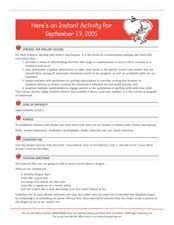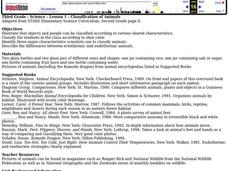Curated OER
Here's an Instant Activity for September 19, 2005
Young writers study similes and then complete a writing activity for similes. They complete a teacher-led activity for similes and then work independently to write sentences using the given similes. A solid lesson!
Curated OER
Dragon Genetics ~ Independent Assortment and Genetic Linkage
Imagine a pair of dragons that produce offspring. What percentage of the hatchlings have wings and large antlers? An engaging activity draws genetics learners in, introduces them to alleles, meiosis, phenotypes, genotypes, and...
Curated OER
Creature Creation
Young scholars explore the characteristics of dragons as represented in the myths of cultures around the world. They create their own mythical dragons by hybridizing two creatures with desirable traits and writing stories about their...
American Museum of Natural History
What's This? Staying Safe
Amaze the class with the creative adaptations species employ to trick predators. An online interactive lesson introduces learners to six different species with unique adaptations. Each species highlights a different adaptation and its...
Curated OER
Kites
Learners practice estimating and comparing measurements using yards, feet, and inches. They make comparisons about kites and a variety of measurements. Afterwards, they complete an activity sheet and draw a bird kite with long wings and...
Curated OER
Week 7: Animal Adaptations - Bird Beaks
Students use tools to represent bird beaks and pick up different types of food with them in order to discover which beak would help the bird survive depending on their food type.
Curated OER
Introduction to Adaptation
Tenth graders observe collections of specimens and discuss their answers to provided questions. They explore common ancestry, homology, analogy, adaptive radiation, and evolution, while formulating creative answers based on their...
Curated OER
Classification of Animals
Third graders practice classiyfying items and identify three major characteristics scientists use to classify animals. They describe the differences between ectothermic and endothermic animals.









